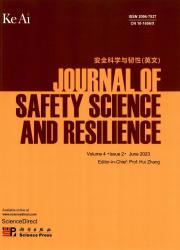A method of characterizing the impact of traffic load on metro system from the control centrality
IF 3.4
Q1 PUBLIC, ENVIRONMENTAL & OCCUPATIONAL HEALTH
引用次数: 0
Abstract
This paper explores the challenges of controlling complex metro systems, which are influenced by uncertain and uncontrollable large passenger flow impacts. Traditionally, flow-limiting measures during peak periods have been based on experience rather than scientific theory. To bridge this gap, we introduce a novel network analysis method inspired by control centrality theory. This approach assesses the impact of traffic loads from single or multiple sources on any node within the metro network. Our method provides a scientific basis for operators to develop policies for managing overloaded traffic, enhancing both safety and efficiency in metro system operations.
一种从控制中心性分析交通负荷对地铁系统影响的方法
本文探讨了复杂地铁系统在不确定、不可控的大客流影响下的控制挑战。传统上,高峰时段的限流措施是基于经验而不是科学理论。为了弥补这一差距,我们引入了一种受控制中心性理论启发的新颖网络分析方法。这种方法评估来自单个或多个源的流量负载对城域网络中任何节点的影响。我们的方法为运营商制定管理超载交通的政策提供了科学依据,提高了地铁系统运营的安全性和效率。
本文章由计算机程序翻译,如有差异,请以英文原文为准。
求助全文
约1分钟内获得全文
求助全文
来源期刊

安全科学与韧性(英文)
Management Science and Operations Research, Safety, Risk, Reliability and Quality, Safety Research
CiteScore
8.70
自引率
0.00%
发文量
0
审稿时长
72 days
 求助内容:
求助内容: 应助结果提醒方式:
应助结果提醒方式:


